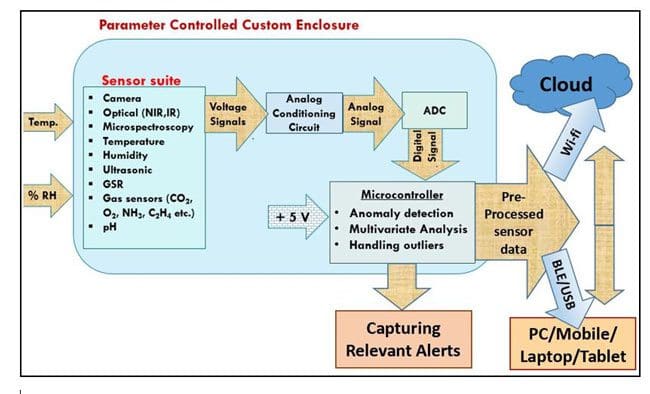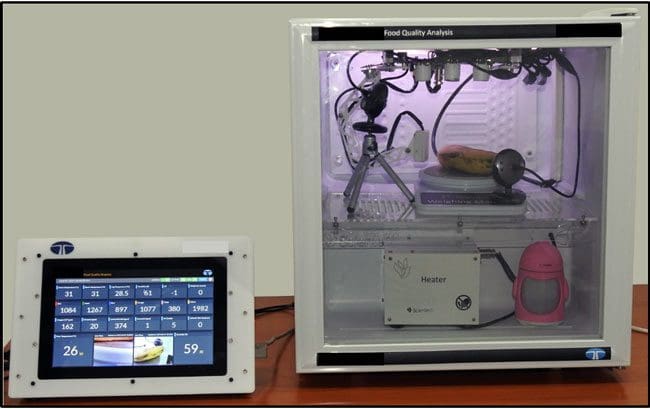Written by Jayita Dutta, Parijat Deshpande, Shankar Kausley, Manasi Patwardhan, Beena Rai, TCS Research
Monitoring of perishable foods using sensors is becoming increasingly popular, and standalone sensors for detecting the freshness of food are already in use. Similarly, Internet of Things (IoT) enabled sensors for sensing, detecting, and utilizing cloud storage for data archiving are a reality today. While these are beneficial as standalone technologies, a single platform capable of integrating a collection of select IoT-enabled sensors, data analytics, and image processing combined with cloud computing has the potential to create a considerable impact on the next-generation food monitoring solutions.
In this article, a novel platform is outlined where all the above-mentioned technologies are integrated in order to develop an integrated sensing and monitoring solution capable of monitoring and providing quantitative assessment in real time along with the prediction of food quality in terms of freshness index and remaining shelf life. Selection of sensors such as carbon dioxide (CO2), ethylene, and ammonia depends upon the type of perishable food to be monitored such as fresh fruits, fresh vegetables, dairy products, fish and meat. This platform is housed within a custom designed temperature and humidity-controlled enclosure so as to recreate field conditions. Additionally, this platform incorporates food specific hybrid respiration rate models based on rate kinetics which is further augmented by data collected via a series of experiments. These artificial intelligence (AI) / machine learning (ML) and rate kinetics-based hybrid models provide a correlation between sensory and chemically analyzed parameters and act as soft sensors that can be deployed in the field for real-time prediction of the degree of freshness and shelf life of the selected foods.
What is the need for such a system?
Monitoring of perishable food is highly essential, to ensure that food is consumed in its ideal conditions and prevent health hazards arising due to the consumption of partially or completely spoiled food. Food degradation causes a change in the chemical composition such as sugar, minerals, vitamins etc. which can be caused by the variation in its environmental parameters such as temperature, pressure, relative humidity and self-emitted gases such as CO2, ethylene, and ammonia. This degradation in food further can be attributed to the time delay at different stages of the supply chain.
However, this degradation may not be evident by mere visual observations creating the need for a quantitative assessment of foods in real-time. Further, according to the Food and Agriculture Organization of the United Nations, global food wastage accounts to 1.3 billion tons annually, out of which 40-45% corresponds to fruits, vegetables and root crops wastage¹. Further Food and Agricultural Organization of the United Nations have targeted path to zero hunger and transforming food and agriculture to achieve the sustainable development goals (SDGs) by 2030². SDGs mainly focuses on global food loss and wastage. Thus, this platform will assist the supply chain stakeholders in dynamic decision-making regarding logistics or repurposing to minimize food spoilage and wastage.
¹ – http://www.fao.org/save-food/resources/keyfindings/en/
² – http://www.fao.org/sustainable-development-goals/en/
The Platform
The system architecture and operational methodology of this platform, capable of real-time assessment of food freshness index are depicted in Fig 1. The platform is housed in a custom designed parameter-controlled enclosure which allows provision for variation of environmental conditions such as temperature, humidity, and light intensity, thus simulating the conditions similar to those experienced infield, during storage, and transit conditions. One or more integrated, modular sensors suites mounted inside the enclosure, are inclusive of sensors such as near infrared (NIR), galvanic skin resistance (GSR), gases (like CO2, O2, NH3, C2H4 etc.), temperature, humidity, pH and volatile organic compound (VOC) along with multiple high-resolution cameras. Camera and sensors provide for multivariate synchronized data collection covering multiple directions at predefined intervals. NIR reflectance spectra measure light scattered off the food in the near infrared region of the electromagnetic spectrum (from about 700 nm to 2500 nm) and facilitate non-destructive detection of damaged spots in the food. GSR sensor is suitably modified to measure minute changes with regard to skin resistance of foods that could detect the commencement of its degradation. This integrated sensor suite is built on a modular framework where existing sensors can be removed or additional sensors can be plugged-in depending upon the nature of food. The sensed voltage signals are converted to a digital output and processed via a microcontroller and interfaced with PC/laptop/tablets/smartphones via Bluetooth Low Energy (BLE) module. The data is further sent to a data cloud to allow online real-time monitoring of quantitative sensed parameters across the globe. The schematic of the integrated platform is represented in Fig 2.

Fig. 1. System Architecture & Working Methodology

Fig 2: The integrated platform with data console and enclosure
The sensory and image data collected over time along with chemical analysis performed periodically are analyzed to find data correlation, develop machine learning models and predict remaining shelf life or quantitative degree of freshness of perishable food. The platform performs a time series analysis where every time step takes the sensory and visual input along with chemically analyzed parameters at a time instance in the lifetime of perishable food. The model used is a recurrent neural network (RNN) which takes into consideration the dependencies of prior time steps while predicting the output for current or future time-step of the time series data. Prior to feeding the visual input to the RNN model, it is fed to a pre-trained convolution neural network (CNN) to extract features of the image. The inclusion of visual contents using CNNs provides a visual embedding of the food, which is a vectorized representation of the food. A single weight shared CNN network is used across the time steps of the RNN model. This vectorized representation provides a standardized digital signature of that food from a freshness perspective. The embedding provided by this trained CNN model for images of distinct foods can be compared with this standardized representation using vector similarity measures to predict the freshness index or remaining shelf life. Furthermore, the predicted freshness will enable the development of a feedback system to alter the environmental conditions to increase shelf life or repurpose the commodity (such as ship it to a nearby location or take other appropriate alternatives) and thus reduce food wastage.
Use Case: To predict the freshness & shelf life of potatoes
Depending upon their intended use, potatoes are processed post-harvest under different environmental conditions, through various stages of the supply chain, from farms to fork. Potatoes specifically intended for chips production need to be stored under specific controlled conditions to ensure good quality chips. However, monitoring and feedback control are essential to ensure the quality of potatoes during the entire duration of storage. The commencement of degradation can trigger the control of environmental conditions so as to prevent further degradation and contain losses. The platform developed by TCS Research was used to record the quantitative variation in sensory data, images along with changes in chemical composition in terms of the sugar and starch of potatoes, over time, under controlled conditions experienced in cold storages. The variation in sensory data, image, and chemical analysis were combined to develop a regression model based on rate kinetics augmented with data to predict the freshness index of potatoes in terms of change in sugar content, starch content, fungal growth, the emission of CO2 and ethylene gases and weight loss. The model was further used to predict the remaining shelf life of potatoes and in turn predict the usability of the potatoes for production of chips for sugar content less than the stipulated value or for repurposing for other applications such as seeding, domestic use, and animal fodder.
Addressing the global challenge of hunger and food wastage
This novel integrated platform is designed to add significant value in performing routine checks for a wide range of application areas including supermarkets, food processing & supply chain industry. This platform can also assist individuals as a decision support system by using its capability of quantitative measurements to detect possible degradation in quality from the various measured parameters. The ability to quantitatively ascertain the degree of food freshness and remaining shelf life will further ensure food consumption safety, allow for alteration of logistics and delivery schedule and to take corrective measures by changing the environmental conditions. This will further help in increasing the shelf life and facilitate opportunities to repurpose foods rather than completely discard the food produce. Thus, this work attempts to address a much larger problem of food wastage and will be a key enabler in addressing the global hunger problem.
To learn more about related IEEE Standards Association activities, visit the Life Sciences web page today.
UPDATE: This article was updated with additional information and statistics from the United Nations Food and Agriculture Organization.

